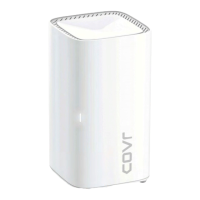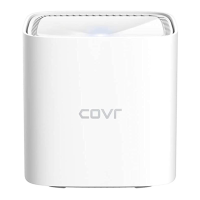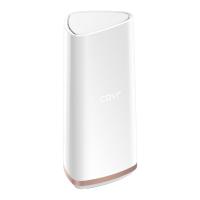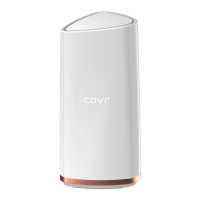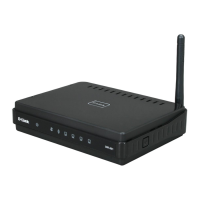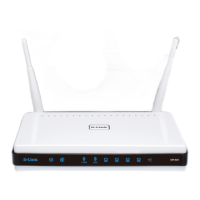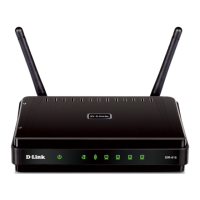Do you have a question about the D-Link COVR-1102 and is the answer not in the manual?
Details about manual versioning and release date.
Lists trademarks and copyright information.
Information on the device's energy consumption in Network Standby mode.
Explains how to extend the mesh network by adding more COVR units.
Details the benefits of Wi-Fi CERTIFIED EasyMesh ™ technology.
Describes the wireless speeds and wired connectivity options.
Discusses automatic firmware updates for the COVR unit.
Highlights the ease of setting up the COVR system via app or web interface.
Explains the meaning of different LED status lights on the COVR-1100 unit.
Displays the current status of the COVR Wi-Fi network via an interactive diagram.
Shows the status when the COVR Point is connected to the Internet.
Shows the status when the COVR Point is not connected to the Internet.
Displays IPv4 network configuration details for the COVR-1100.
Displays IPv6 network configuration details for the COVR-1100.
Shows the Wi-Fi status, name (SSID), and password for the COVR-1100.
Launches the step-by-step setup wizard for the COVR Wi-Fi system.
Configures the IPv4 Internet connection type and settings.
Enter the username and password provided by your ISP.
Configure how the connection is maintained during inactivity.
Select IP address mode and configure related settings like Service Name, DNS, and MTU.
Enter PPTP server IP, username, and password from your ISP.
Configure address mode and other settings like PPTP IP, subnet mask, and gateway.
Enter L2TP server IP, username, and password from your ISP.
Configure address mode and other settings like L2TP IP, subnet mask, and gateway.
Automatically detects and configures the IPv6 connection method.
Configures DNS server settings for IPv6.
Configures IPv6 address settings for the local network.
Enable or disable the use of link-local addresses for static IPv6.
Enter the static IPv6 address and subnet prefix length provided by your ISP.
Configures DNS server settings for IPv6 auto-configuration.
Configures LAN IPv6 address settings for auto-configuration.
Options for creating or managing PPPoE sessions for IPv6.
Select IP mode and enter ISP-provided credentials for IPv6 PPPoE.
Advanced settings for Unique Local IPv6 Unicast Addresses.
Settings for enabling and configuring Triple-Play VLAN features.
Configures VLAN settings for different LAN ports.
Sets the name for the COVR Wi-Fi network.
Creates a password for the COVR Wi-Fi network.
Enables Dynamic Frequency Selection for 5 GHz channels.
Selects the wireless channel width for optimal performance.
Manages the LAN IP address, subnet mask, and management link for the COVR Point.
Configures ALG settings for specific protocols like PPTP, IPSec, RTSP, and SIP.
Details about manual versioning and release date.
Lists trademarks and copyright information.
Information on the device's energy consumption in Network Standby mode.
Explains how to extend the mesh network by adding more COVR units.
Details the benefits of Wi-Fi CERTIFIED EasyMesh ™ technology.
Describes the wireless speeds and wired connectivity options.
Discusses automatic firmware updates for the COVR unit.
Highlights the ease of setting up the COVR system via app or web interface.
Explains the meaning of different LED status lights on the COVR-1100 unit.
Displays the current status of the COVR Wi-Fi network via an interactive diagram.
Shows the status when the COVR Point is connected to the Internet.
Shows the status when the COVR Point is not connected to the Internet.
Displays IPv4 network configuration details for the COVR-1100.
Displays IPv6 network configuration details for the COVR-1100.
Shows the Wi-Fi status, name (SSID), and password for the COVR-1100.
Launches the step-by-step setup wizard for the COVR Wi-Fi system.
Configures the IPv4 Internet connection type and settings.
Enter the username and password provided by your ISP.
Configure how the connection is maintained during inactivity.
Select IP address mode and configure related settings like Service Name, DNS, and MTU.
Enter PPTP server IP, username, and password from your ISP.
Configure address mode and other settings like PPTP IP, subnet mask, and gateway.
Enter L2TP server IP, username, and password from your ISP.
Configure address mode and other settings like L2TP IP, subnet mask, and gateway.
Automatically detects and configures the IPv6 connection method.
Configures DNS server settings for IPv6.
Configures IPv6 address settings for the local network.
Enable or disable the use of link-local addresses for static IPv6.
Enter the static IPv6 address and subnet prefix length provided by your ISP.
Configures DNS server settings for IPv6 auto-configuration.
Configures LAN IPv6 address settings for auto-configuration.
Options for creating or managing PPPoE sessions for IPv6.
Select IP mode and enter ISP-provided credentials for IPv6 PPPoE.
Advanced settings for Unique Local IPv6 Unicast Addresses.
Settings for enabling and configuring Triple-Play VLAN features.
Configures VLAN settings for different LAN ports.
Sets the name for the COVR Wi-Fi network.
Creates a password for the COVR Wi-Fi network.
Enables Dynamic Frequency Selection for 5 GHz channels.
Selects the wireless channel width for optimal performance.
Manages the LAN IP address, subnet mask, and management link for the COVR Point.
Configures ALG settings for specific protocols like PPTP, IPSec, RTSP, and SIP.
| DC-in jack | Yes |
|---|---|
| Ethernet LAN (RJ-45) ports | 2 |
| Wi-Fi band | Dual-band (2.4 GHz / 5 GHz) |
| Wi-Fi standards | 802.11a, 802.11g, Wi-Fi 4 (802.11n), Wi-Fi 5 (802.11ac) |
| Cabling technology | 10/100/1000Base-T(X) |
| Security algorithms | WPA-PSK, WPA2, WPA2-PSK, WPA3 |
| Networking standards | IEEE 802.11a, IEEE 802.11ac, IEEE 802.11g, IEEE 802.11n |
| Wi-Fi data rate (max) | 866 Mbit/s |
| Certification | FCC, IC, CE, ErP |
| Product color | White |
| LED indicators | Status |
| Antenna type | Internal |
| Type | Network transmitter |
| Ethernet LAN data rates | 10, 100, 1000 Mbit/s |
| Maximum transfer distance | - m |
| AC input voltage | 100 - 240 V |
| AC input frequency | 50 - 60 Hz |
| Power consumption (max) | 8.55 W |
| Storage temperature (T-T) | -20 - 70 °C |
| Operating temperature (T-T) | 0 - 40 °C |
| Storage relative humidity (H-H) | 5 - 90 % |
| Operating relative humidity (H-H) | 10 - 90 % |
| Sustainability certificates | RoHS |
| Flash memory | 16 MB |
| Internal memory | 128 MB |
| Harmonized System (HS) code | 85176990 |
| Depth | 92 mm |
|---|---|
| Weight | 197 g |


